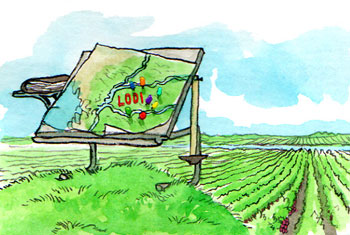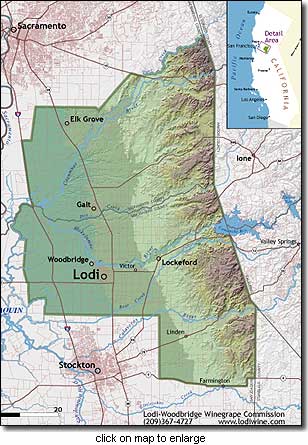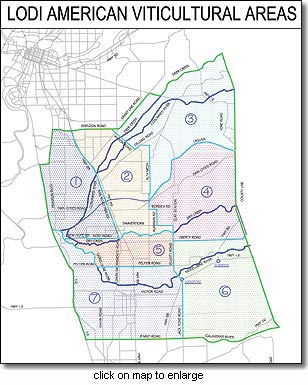

Drafting Lodi’s seven new sub-appellations was a monumental undertaking of historical, climatic, and geological research.
Lodi Architects Seven New Appellations
After three years in bureaucratic limbo, Lodi producers can now designate more specific origins for their wines.
by
Dave Chandler
July 31, 2006
The Lodi American Viticultural Area (AVA) is rapidly becoming recognized as one of the most prolific grape growing regions in the world. Of the 552,000 acres that comprise the Lodi appellation nearly 100,000 are planted with winegrapes, producing more of the top five California varietals – Cabernet Sauvignon, Chardonnay, Merlot, Sauvignon Blanc and Zinfandel – than any other wine district in the state, and more ‘Zin’ than any other district in the world.

Because of its sheer vastness, the simple ‘Lodi’ designation fails to articulate the wide diversity of terroir that exists within the half million acres of the appellation. The ecological differences inherent to various areas of the Lodi AVA directly affect the characteristics of wine made from grapes grown in different parts of the expansive district.
This issue of ambiguity motivated a small group of local growers and vintners to initiate the process for the creation of sub-appellations within the existing Lodi appellation. These would allow local wineries to employ appellation-specific marketing and education tactics and local growers to increase the prestige and price of their fruit once wines made from grapes grown in their sub-appellation received recognition and acclaim. This formula has proven successful for a number of sub-appellations such as the Los Carneros AVA in Napa.
The movement began when local grower and winery-owner Markus Bokisch wanted to create a sub-appellation in the eastern portion of Lodi in the Clement Hills, where his eponymous named winery, Bokisch Vineyards, and the majority of his vineyards are located. After preliminary research, Bokisch realized that to distinguish the unique qualities of the Clements Hills it was necessary to define the other regions of Lodi in order to provide a context for comparing the other sub-appellations. Bokisch and grower turned winery-owner Keith Watts created the Lodi American Viticultural Areas Steering committee which, with the assistance of the Lodi-Woodbridge Winegrape Commission and the Lodi Appellation Wineries Association, held meetings to field the questions of the Lodi wine and viticulture community.
Two chief concerns were that the larger wineries would oppose the creation of sub-appellations because it would drive the prices of grapes higher, raising costs for wineries and potentially making it difficult for growers to find buyers after harvest. The second objection was that since Lodi has really only been promoting itself as a premium wine producer for the last twenty years, many people felt that it was too soon to roll out seven new vehicles for marketing Lodi wines, fearing the Lodi name was not yet established enough to exchange it for appellation names unfamiliar to the consumer.
Resolution of these concerns was swift; two of the five largest producers in Lodi, Delicato and Sutter Home, embraced the creation of the sub-appellations while the other three stayed neutral. The second issue was settled with a compromise. Wineries could use both ‘Lodi’ as well as the sub-appellation name on their labels, alleviating the concern that the new sub-appellations would weaken the Lodi name, which the Lodi-Woodbridge Winegrape Commission had worked so hard to establish.
After Bokisch and Watts had garnered enough support for the project they enlisted the aid of the Lodi-Woodbridge Winegrape Commission and Lodi Appellation Wineries Association, formed the Lodi Appellation Viticultural Areas (LAVA) committee and created focus groups to research and decide on a name for each of the distinct viticultural areas within the greater Lodi Appellation.
The combined efforts of the Lodi American Viticulture Areas, the Lodi-Woodbridge Winegrape Commission, and the Lodi Appellation Wineries Association yielded the most extensive historical and science-based document outlining the diversity in climate, soil, topography, and elevation of any appellation ever to be submitted to the Alcohol Tax and Trade Bureau (TTB), known at that time as the Bureau of Alcohol, Tobacco, and Firearms (BATF).
The conclusion of their research was that seven distinct growing regions exist in the greater Lodi Appellation and deserve recognition as individual and distinct viticultural regions. Their names are Alta Mesa, Borden Ranch, Clements Hills, Cosumnes River, Jahant, Mokelumne River and Sloughhouse.
Paradoxically, the immense speed and efficiency with which the document was researched and produced was met by the BATF/TTB with an equal degree of sluggishness. The LAVA committee submitted their research document petitioning for the creation of seven separate AVAs in the fall of 2002. In January 2003, the BATF was transformed into the TTB, and the approval of the seven sub-appellations did not come until July 19, 2006.
Beginning on August 20, 2006, wineries will be able to designate the new appellation names on their labels. The three year interim period between the initial proposal and final approval was no doubt in part related to the bureaucratic transition from the BATF to the TTB. Another factor in the slow resolution was that the document submitted was by far the largest and most thoroughly researched petition ever submitted. In fact, the scientific research and documentation submitted by LAVA was so thorough that other appellations such as Paso Robles are using the same method, calling it “The Lodi Model.”
Now that Lodi has received approval and the seven appellations have been created the work falls to the vintners, winemakers and marketers of the Lodi viticultural community to effectively educate the wine consumer with an understanding and appreciation for each individual appellation through the unique characteristics of their wines.
To that end, a brief explanation of each of Lodi’s seven new appellations can be found below.
Alta Mesa AVA – This appellation, located in northern central Lodi, has 55,400 acres of which 5,300 are are under vine. As its name suggests (Spanish for high-table) this area is distinguished by its mesa-like elevation, ranging from 35 t

Because of its sheer vastness, the simple ‘Lodi’ designation fails to articulate the wide diversity of terroir that exists within the half million acres of the appellation. The ecological differences inherent to various areas of the Lodi AVA directly affect the characteristics of wine made from grapes grown in different parts of the expansive district.
This issue of ambiguity motivated a small group of local growers and vintners to initiate the process for the creation of sub-appellations within the existing Lodi appellation. These would allow local wineries to employ appellation-specific marketing and education tactics and local growers to increase the prestige and price of their fruit once wines made from grapes grown in their sub-appellation received recognition and acclaim. This formula has proven successful for a number of sub-appellations such as the Los Carneros AVA in Napa.
The movement began when local grower and winery-owner Markus Bokisch wanted to create a sub-appellation in the eastern portion of Lodi in the Clement Hills, where his eponymous named winery, Bokisch Vineyards, and the majority of his vineyards are located. After preliminary research, Bokisch realized that to distinguish the unique qualities of the Clements Hills it was necessary to define the other regions of Lodi in order to provide a context for comparing the other sub-appellations. Bokisch and grower turned winery-owner Keith Watts created the Lodi American Viticultural Areas Steering committee which, with the assistance of the Lodi-Woodbridge Winegrape Commission and the Lodi Appellation Wineries Association, held meetings to field the questions of the Lodi wine and viticulture community.
Two chief concerns were that the larger wineries would oppose the creation of sub-appellations because it would drive the prices of grapes higher, raising costs for wineries and potentially making it difficult for growers to find buyers after harvest. The second objection was that since Lodi has really only been promoting itself as a premium wine producer for the last twenty years, many people felt that it was too soon to roll out seven new vehicles for marketing Lodi wines, fearing the Lodi name was not yet established enough to exchange it for appellation names unfamiliar to the consumer.
Resolution of these concerns was swift; two of the five largest producers in Lodi, Delicato and Sutter Home, embraced the creation of the sub-appellations while the other three stayed neutral. The second issue was settled with a compromise. Wineries could use both ‘Lodi’ as well as the sub-appellation name on their labels, alleviating the concern that the new sub-appellations would weaken the Lodi name, which the Lodi-Woodbridge Winegrape Commission had worked so hard to establish.
After Bokisch and Watts had garnered enough support for the project they enlisted the aid of the Lodi-Woodbridge Winegrape Commission and Lodi Appellation Wineries Association, formed the Lodi Appellation Viticultural Areas (LAVA) committee and created focus groups to research and decide on a name for each of the distinct viticultural areas within the greater Lodi Appellation.
The combined efforts of the Lodi American Viticulture Areas, the Lodi-Woodbridge Winegrape Commission, and the Lodi Appellation Wineries Association yielded the most extensive historical and science-based document outlining the diversity in climate, soil, topography, and elevation of any appellation ever to be submitted to the Alcohol Tax and Trade Bureau (TTB), known at that time as the Bureau of Alcohol, Tobacco, and Firearms (BATF).
The conclusion of their research was that seven distinct growing regions exist in the greater Lodi Appellation and deserve recognition as individual and distinct viticultural regions. Their names are Alta Mesa, Borden Ranch, Clements Hills, Cosumnes River, Jahant, Mokelumne River and Sloughhouse.
Paradoxically, the immense speed and efficiency with which the document was researched and produced was met by the BATF/TTB with an equal degree of sluggishness. The LAVA committee submitted their research document petitioning for the creation of seven separate AVAs in the fall of 2002. In January 2003, the BATF was transformed into the TTB, and the approval of the seven sub-appellations did not come until July 19, 2006.
Beginning on August 20, 2006, wineries will be able to designate the new appellation names on their labels. The three year interim period between the initial proposal and final approval was no doubt in part related to the bureaucratic transition from the BATF to the TTB. Another factor in the slow resolution was that the document submitted was by far the largest and most thoroughly researched petition ever submitted. In fact, the scientific research and documentation submitted by LAVA was so thorough that other appellations such as Paso Robles are using the same method, calling it “The Lodi Model.”
Now that Lodi has received approval and the seven appellations have been created the work falls to the vintners, winemakers and marketers of the Lodi viticultural community to effectively educate the wine consumer with an understanding and appreciation for each individual appellation through the unique characteristics of their wines.

To that end, a brief explanation of each of Lodi’s seven new appellations can be found below.
Alta Mesa AVA – This appellation, located in northern central Lodi, has 55,400 acres of which 5,300 are are under vine. As its name suggests (Spanish for high-table) this area is distinguished by its mesa-like elevation, ranging from 35 t














